ASUS F2A85-V Pro Review: A Look at FM2 with A85X
by Ian Cutress on October 10, 2012 11:20 AM EST- Posted in
- Motherboards
- Asus
- Trinity
- FM2
- A85X
3D Movement Algorithm Test
The algorithms in 3DPM employ both uniform random number generation or normal distribution random number generation, and vary in various amounts of trigonometric operations, conditional statements, generation and rejection, fused operations, etc. The benchmark runs through six algorithms for a specified number of particles and steps, and calculates the speed of each algorithm, then sums them all for a final score. This is an example of a real world situation that a computational scientist may find themselves in, rather than a pure synthetic benchmark. The benchmark is also parallel between particles simulated, and we test the single thread performance as well as the multi-threaded performance.
It should be noted that this benchmark is a purely floating point benchmark, indicative of a lot of research written code where several months of optimization is not possible or not common knowledge within the research group. The compiler is not clever enough to convert what is expected into appropriate integer conversions, so Bulldozer and Piledriver based processors will only perform as well as their singular FPU units per module will allow. The benchmark is unaffected by memory speed as thread creation is created on the CPU and all data created fits well within the L2 cache per core.
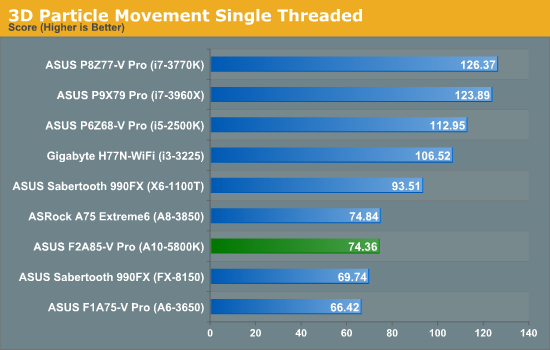
In the single threaded test, a lot of conclusions can be drawn from the comparison of AMD architectures. Direct comparison of Piledriver to Bulldozer (A10-5800K to FX-8150) gives a boost in single core performance of 7%, however comparing the old Stars cores of the A8-3850 at 2.9 GHz is roughly the same as the new Piledriver core at 4.2 GHz. So even with a 1.3 GHz advantage, Piledriver is only as good as Stars and less efficient in floating point results. If we compare Piledriver to Thuban, i.e. A10-5800K to X6 1100T, the Piledriver core gets stomped on by a good 25% performance. I find this quite staggering – most of the code I ever encountered as a computational chemist was floating point based, dealing with single and double precision on a regular basis. On this result, I would steer clear of Piledriver.

The multithreaded version of 3DPM is slightly tougher to analyze. Due to the FP nature of the program, the A10-5800K is essentially a 2 core FPU processor, whereas all the other comparative AMD processors have either 4 or 6 FPUs to play with. What is perhaps worth considering is that the Bulldozer processor with 4 modules scores 326.32, whereas the Piledriver processor with only 2 modules scores 203.06, which is more than half. This would mean that the Piledriver core actually achieves 20% better performance at the same frequency, despite our ST test giving Piledriver only a 7% increase. Part of this could be put down to the architecture improvements – improved scheduling for heavily threaded loads, one of the downfalls of Bulldozer but was improved in Piledriver could be the reason here.
WinRAR x64 3.93 - link
With 64-bit WinRAR, we compress the set of files used in the USB speed tests. WinRAR x64 3.93 attempts to use multithreading when possible, and provides as a good test for when a system has variable threaded load. If a system has multiple speeds to invoke at different loading, the switching between those speeds will determine how well the system will do. WinRAR is also very sensitive to memory speeds and subtimings.
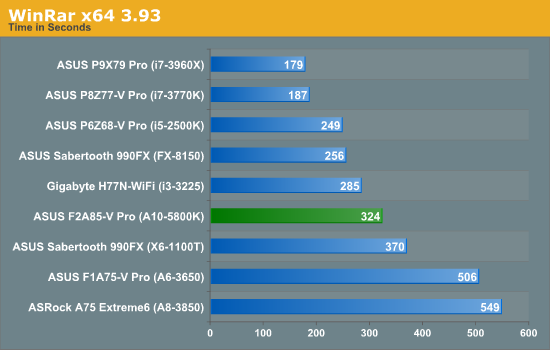
Analyzing the WinRAR results can be a little confusing, given that at different points of our previous testing the memory settings have been different (should point out that they have been consistent when comparing against like-for-like). When the A10-5800K was playing ball with DDR3-2400 10-12-12 memory, the WinRAR copy test pulled out miles ahead of the Thuban and Llano processors by a good margin. However the Sandy Bridge i5-2500K, with 4 INT and 4 FPU units gave the Trinity processor a proverbial thrashing despite being limited to DDR3-1333 at the time of testing.
FastStone Image Viewer 4.2 - link
FastStone Image Viewer is a free piece of software I have been using for quite a few years now. It allows quick viewing of flat images, as well as resizing, changing color depth, adding simple text or simple filters. It also has a bulk image conversion tool, which we use here. The software currently operates only in single-thread mode, which should change in later versions of the software. For this test, we convert a series of 170 files, of various resolutions, dimensions and types (of a total size of 163MB), all to the .gif format of 640x480 dimensions.
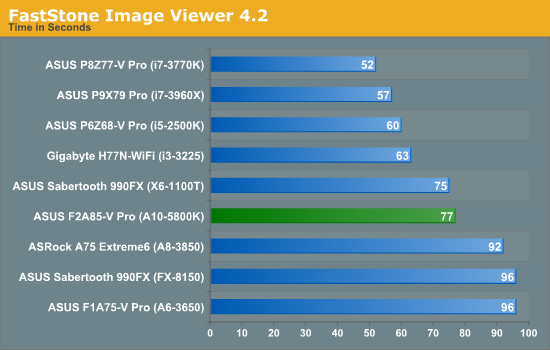
In the FastStone results, we see the Piledriver processor beat the Bulldozer and Stars cores by a considerable margin, and nudge the Thuban as well.
Xilisoft Video Converter
With XVC, users can convert any type of normal video to any compatible format for smartphones, tablets and other devices. By default, it uses all available threads on the system, and in the presence of appropriate graphics cards, can utilize CUDA for NVIDIA GPUs as well as AMD APP for AMD GPUs. For this test, we use a set of 32 HD videos, each lasting 30 seconds, and convert them from 1080p to an iPod H.264 video format using just the CPU. The time taken to convert these videos gives us our result.
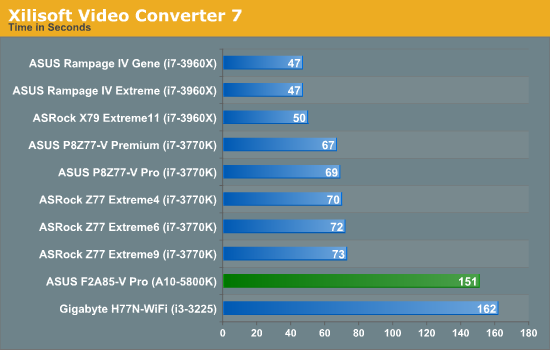
Unfortunately our Xilisoft benchmark is rather new, and thus we do not have results for all the AMD cores we have used in the past. However if we compare the A10-5800K directly with the i3-3225, we unfortunately have a memory difference to contend with (DDR3-2133 vs. DDR3-1600). With that being said, it is clear that video conversion is an INT process and all four of the A10-5800K INT units are being used.
x264 HD 4.0.1 Benchmark
The x264 HD Benchmark uses a common HD encoding tool to process an HD MPEG2 source at 1280x720 at 3963 Kbps. This test represents a standardized result which can be compared across other reviews, and is dependant on both CPU power and memory speed. The benchmark performs a 2-pass encode, and the results shown are the average of each pass performed four times.
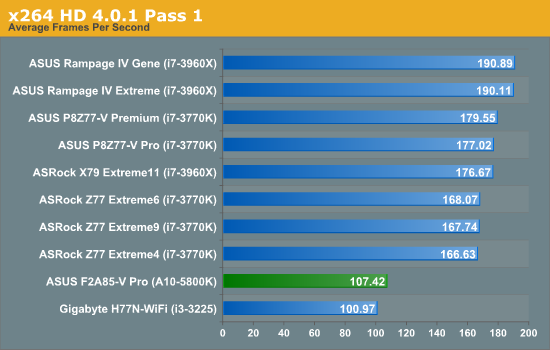
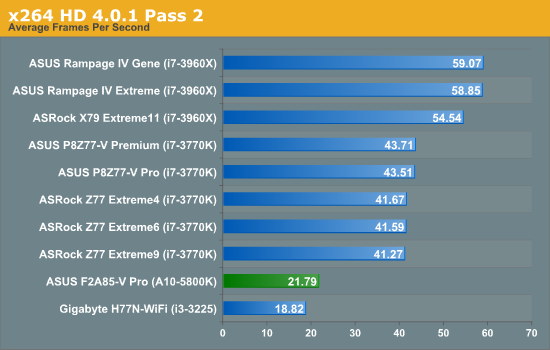










66 Comments
View All Comments
medi01 - Sunday, October 14, 2012 - link
What kind of enthusiasts need CPU more than GPU?Urizane - Monday, October 15, 2012 - link
'Enthusiast' is not exactly equal to 'Gamer'. Gamers don't really need a ton of CPU capability. Enthusiasts may have many CPU bound interests.dsrnet - Monday, April 15, 2013 - link
hi,What is the best 4 core processor ( CPU ) ,stating its clock speed,that it supports? ( F2A85-V PRO mother board ), please let me know.
thanks
Aj
tim851 - Thursday, October 11, 2012 - link
Hehe, my thoughts exactly. I don't hate AMD and wish them a lot of success - primarily for my own sake - but no enthusiast is thinking about Trinity.zappb - Wednesday, October 10, 2012 - link
Ian, What do you think about pairing a low end FM2 processor with a micro ATX version of an A85 or A75 boardBenefits I can see for small office machine that has standard admin workloads - (to compete with the recent budget systems buyer guide say with the pentium G530 recommendation).
Buy going with the Trinity you get -
lower idle power consumption and mostly this builds will run word-excel etc..., so lower TCO
Ability to run 2 monitors and keep lowish power (no need for new GFX) also better GFX in general
Ability to upgrade / more flexibility - with one more processor release arriving for FM2 next year and better chipset options.
Can run encryption / AES - ok not a great processor choice in general but as more small firms realise how important security is, it could be as simple as running 7zip 256 Bit encryption on a few files before emailing them - the processor is not handicapped and Trinity should buy and sell the Pentium in speed.
So take an AMD A4-5300 - 65 USD, and some A85 micro atx variant for say 70 USDand pair it will an Samsung 830/840/ Intel 330128 GB SSD I would suggest this might be a better long term platform than the Intel/G530 combo recommended in the value system buyers guide.
What's the cost? An Extra 40 USD on the low end intel?
just4U - Wednesday, October 10, 2012 - link
Would work fine I'd expect.. but without hands on testing of a lower end FM2 part .. I'd be rather curious about it's overall performance.. Looking at bench results the A10 5800K is in and around 1156 I5 performance (slightly lower on single thread) but very comparable to Quad9X C2D stuff.. which is decent overall with all the additions that come with future tech and ofcourse the graphics.I rather like the 5800/A85X combo myself but it should be about $40 bucks cheaper then it currently is. Still.. not having a problem with it on our secondary system (a 2700K build for the main..) It's certainly fast enough.
just4U - Wednesday, October 10, 2012 - link
Also, one of the things I've seen reviewers mention is .. these new Trinity based setups could make quite the showing in the office or in the living room. I plan on setting up a low cost option for our living room as more selections in boards start to come out.... I also like the fact that the system stays cool.. a major complaint of mine with the Ivy Bridge cpu's that rarely gets even a mention.
CeriseCogburn - Saturday, October 13, 2012 - link
LOL - it's all too clear, and has been for a very long time. AMD fanboyzappb - Saturday, October 13, 2012 - link
Throughout the review, Ian was looking for a reason to recommend why someone would buy FM2.In the context of Zach's excellent value buyer's guide here: http://www.anandtech.com/show/6182/fall-budget-sys...
In that article Zach recommends a Intel Celeron G530 which is insanely cheap at USD 30 but doesn't have some of the instruction sets that AMD don't cut out from cheaper models.
With the motherboard there's about 100 dollars to play with for CPU and Mobo. A75X + low end FM2 - well there just might be room for the right priced FM 2 setup - which might even also be lower power and more flexible.
I'm shortly building 4 machines in our office to replace the final load of XP machines (Win7/Office 2010). It's an accounting office and users tend to use alot of excel and quickbooks. Nothing too taxing on the client side. It will be a tough decision between Intel and AMD.
jabber - Monday, October 15, 2012 - link
Trinity is more than enough for most office workloads.I rolled out a load of dual core Atom boxes for office use between 2010-2011.
Yeah dual core Atoms. Quite pathetic in comparison to Trinity but no complaints, I regularly ask the staff how they are getting on with them and they all still love them.
Folks here are just a little too autistic to see that not everyone works (well for some here I bet the term work is an alien concept in the truest sense) like they do or sees the world in such benchmark obsessed terms.
Most folks have been sorted CPU wise for office work since 2005/6. The stuff most of us play with here is for rich kids toys.